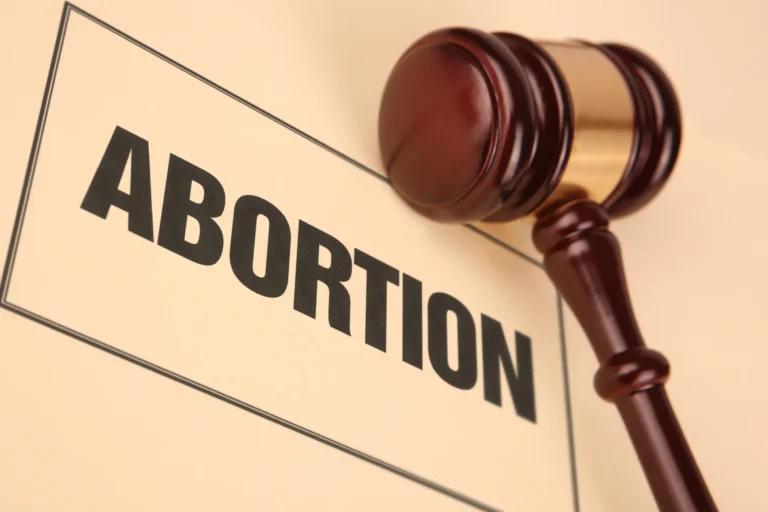Prospects for pro-life victories have increased markedly in recent weeks, as President Trump continues to fulfill the promises he made during the 2016 election campaign.
Vice-President Mike Pence recounted the good news when he addressed those gathered for the National Catholic Prayer Breakfast last week. Pence focused on President Trump’s radical reversal of the anti-life policies that had made Barack Obama the most vocal and pro-abortion national leader in the world.
“President Donald Trump stands with the most vulnerable — the aged, the infirm, and the unborn,” Pence told over a thousand attendees. “Since day one of this administration, President Donald Trump has been keeping his promise to stand for life, and life is winning in America again.
“Let me say from my heart,” he continued, “it’s the greatest privilege of my life to serve as Vice President for President Donald Trump, but I couldn’t be more proud to serve as Vice President to a President who stands without apology for the sanctity of human life,
“He’s actually taken even more action than I’ve mentioned thus far. The President actually has empowered states to withhold federal funding from abortion providers, and I’m humbled to say that, at the President’s direction, I had the privilege of casting the tie-breaking vote in the United States Senate that allows states to defund Planned Parenthood.”
This is all good news to prolife, profamily folks, but there one intriguing point that we haven’t seen anyone mention. surrounding Vice-President Pence happily recounted his Catholic upbringing, and left us with a question.
At the prayer breakfast, Pence waxed eloquent in his praise for the Catholic Church, and for the education he received in eight years of Catholic parochial school.
“I’m the son of two devout American Catholics,” he said, “and the grandson and the namesake of an Irish immigrant and his wonderful wife.… even though my official biography says I was raised in a large Catholic family, I’m actually from a mid-sized Catholic family – there were only six children in the family I grew up.
That definitely got a laugh.
“I want to tell you,” he continued, “as a young boy growing up in a small town in southern Indiana, my Catholic faith poured an eternal foundation in my life.
“I really grew up with a front-row seat to the Catholic faith and all that it means to families and to communities. It gave me a deep appreciation for the Church’s rich contributions to the fabric of American life.
“The truth is Catholicism is woven deep into that fabric. It gives America a vitality and vibrancy that inspires everyone who sees it — to this very day.
“Catholicism has made an indelible mark on the American spirit. Your faith has moved mountains, and the Catholic Church and its millions of parishioners have been a force for good in our communities, large and small, throughout our land, throughout our history.
To all the great American Catholics gathered here, let me assure you this morning, bright and early at this prayer breakfast, American Catholics have an ally in President Donald Trump.”
Clearly the vice president loves the Catholic Church.
And yet he left.
That’s right. Mike Pence is now an Evangelical – “My own faith journey has taken me and my family in a different direction,” he told the gathering. And there arises an interesting question: Did anyone ask him why?
These days, we live in a pastoral time zone. Have any of our bishops or priests who regularly lambaste Pence and Trump ever “reached out to the peripheries” and offered to “accompany the Vice-President in his journey” back to the one true Church? Did Father Jenkins at Notre Dame last month, when Pence spoke at commencement? And last week in Washington, Pence was surrounded by active, engaged Catholics. Did anyone ask him why this grateful former altar boy left the Church?
When Pence was Governor of Indiana two years ago, he clashed with Joseph Cardinal Tobin, C.Ss.R., at the time the Archbishop of Indianapolis, over Abp. Tobin’s insistence that Muslim immigrants be settled in the archdiocese in spite of the Governor’s opposition.
The two met on Dec. 2, 2015 to discuss the matter, after which Governor Pence told the media that “I disagree with the Church.”
But wait – did Pence disagree with Church teaching, or with Abp. Tobin’s personal opinions?
The teaching of the Church contained in the Catechism, No. 2241 tells us that it is “political authorities” who “make the exercise of the right to immigrate subject to various juridical conditions.”
In their conversation, did the archbishop acknowledge the governor’s authority? Or did he actually tell him that it was the Church, and not the archbishop, that Governor Pence disagreed with?”
We don’t know. But almost a year later, in an appearance at Notre Dame’s Center for Civil and Human Rights on October 14, 2016, Abp. Tobin pointedly mocked Pence’s request that they prayerfully consider the question together.
And that got a laugh too.
Had the archbishop reached out to Pence, the cradle Catholic, to ask him why he left? Did he invite Pence to reconsider, to come home to the Church of his baptism? Did he advise the governor that their prudential differences would not at all interfere with that invitation?
We don’t know. But Tobin’s defiance of the governor caught the attention of Pope Francis, who quickly plucked him out of Indiana to name him the Cardinal Archbishop of Newark, where he now goes out of his way to welcome homosexual activist leaders to his cathedral.
When we come back – where do the issues of life and family stand as we approach the 49th anniversary of Humanae Vitae?
Segment Two
In the first months of his term, President Trump has made sweeping moves to reverse the radical pro-abortion policies of the Obama administration. He has appointed to the Supreme Court and to several lower courts judges who will follow the Constitution, rather than impose their own opinions about what the law ought to be. The president has reinstituted and then expanded the Mexico City Policy, meaning that over eight billion taxpayer dollars a year will no longer go to organizations that perform abortions worldwide. He has proposed a budget that completely defines Planned Parenthood, the largest abortion provider in the country.
And yet, for some reason, America’s Catholic bishops cannot bring themselves to applaud these profound policy changes that will save thousands, even millions of innocent lives.
Nor will they rise in outrage to condemn the Democratic National Committee for its new official policy, enunciated by Chairman Tom Perez, that only pro-abortion candidates will qualify for the party’s endorsement in future elections.
Why the silence? Are the bishops actually liberal Democrats in disguise?
Of course not. It is true that most of today’s bishops, like me, and like most Catholics our age, grew up in Democrat families. But 50 years ago, according to historian James Hitchcock, the majority of pro-lifers in the United States were Democrats.
Of course, we know that those days are over – certainly for elected officials nationwide. And nostalgia and family history do not explain the reluctance of our bishops to recognize that the Democrats, the party of our parents, have since become the party of death.
A look at some history might be helpful.
For the past fifty years, the Democrats in Congress have supported the bishops’ welfare agencies with hundreds of millions of dollars a year of taxpayer funding. Moreover, Catholic institutions like colleges, universities, and hospitals have received billions more.
Here’s one example. For a single appearance, Notre Dame received thirty million dollars of taxpayer funding after Obama was awarded an honorary doctorate of laws at the University’s 2009 commencement.
During Obama’s speech, the University arrested 88 pro-life demonstrators on the other end of campus while ignoring pro-Obama demonstrators. The stakes were simply too high – and at the end of the year, the reason became clear, when Notre Dame bragged that Obama’s grant had made 2009 the most successful fundraising year in Notre Dame’s history.
But Obama was the most pro-abortion president in history! That didn’t matter.
At first, Notre Dame’s president, Father John Jenkins, CSC, explained away the invitation to Obama by insisting that it was the office, and not the office-holder, that the University was honoring.
Did he really believe that? No. When the prospect of inviting President Trump to last month’s commencement arose, Father Jenkins bowed to the snowflakes of the campus Left and invited Pence instead.
Undoubtedly Father Jenkins knew that there was no way the Trump Administration was going to send Notre Dame thirty more pieces of silver in exchange for the priceless seal of approval of the nation’s premier Catholic university. After all, Notre Dame is building a new stadium that will cost upwards of 400 million dollars. Father Jenkins has changed what he calls the “crossroads” of the campus from Sacred Heart Basilica to the football field. Obama was more than willing to pay $30 million of taxpayer money for the privilege of pirouetting around the stage at Notre Dame. There’s no way Donald Trump was going to make that deal.
But Notre Dame is just a microcosm that reflects a crisis in the Catholic Church today – one that mingles money with morals, and clerics with clericalism. In coming weeks we’ll be taking a closer look at this pressing problem.
Here’s a quick overview.
America’s leading bishops have privately admitted that voluntary contributions from the people in the pews virtually collapsed after the explosive revelation of the clerical abuse and cover-up scandals 15 years ago. While a tiny minority of priests proved to be abusers, a majority of the bishops in America were shown to be guilty of harboring, protecting, and even abetting them. And none of them quit.
Another reason for the collapse of contributions, lies in the sad fact that at least 30 million Catholics have simply left the pews. While this stunning figure is acknowledged by leading bishops, the conference have never attempted to determine why a third of America’s Catholics have bailed out – although a conference official assures us that a future study might be conducted.
Both of these factors meant that the bishops could no longer depend on the faithful for funding the work of the Church. They had to look elsewhere.
Beginning in the 1960s, the bishops’ prominent welfare agencies, Catholic Relief Services and Catholic Charities USA, became virtual adjuncts to the Democratic party, responding not only to the so-called “spirit of Vatican II,” but also the infusion of billions of dollars over the years designated for Catholic institutions by the Democrat Congress.
But aren’t the Democrats now officially the pro-abortion party?
Yes. But while the Democrats changed, our bishops have not.
And while the head of the Democrat National Committee now declares that the Democrat Party will now support only pro-abortion candidates, our bi
shops are torn: not only nostalgia, but money, is in play.
That’s why, even as the Democrats championed so-called abortion rights,
America’s bishops chose to ignore Canon Law, specifically Canon 915, regarding each bishop’s consecrated responsibility to condemn publicly the manifest scandal of so-called Catholic politicians support abortion.
Let’s take another look at Tom Perez, the chairman of the Democratic National Committee who insists that the party will now endorse only pro-abortion candidates. Perez is a Catholic. In fact, he brags about his Jesuit education.
Yet no bishop has spoken up demanding that he be barred from receiving the Eucharist, as required by Canon Law.
Timothy Cardinal Dolan of New York, who heads the conference’s pro-life office, simply said that he found Perez’s new rule “disturbing.”
Did he tell Perez – publicly – that maybe he should refrain from receiving Communion?
No. In fact, in 2014 Cardinal Dolan announced that Canon 915 is passé.
When reporter John Allen asked him why bishops would not follow Canon Law, the cardinal said,
“By now that inflammatory issue is in the past. I don’t hear too many bishops saying it’s something that we need to debate nationally, or that we have to decide collegially. I think most bishops have said, ‘We trust individual bishops in individual cases.’ Most don’t think it’s something for which we have to go to the mat.”
Translated, the Cardinal is admitting that “most bishops” simply ignore the law of the Church. Put another way, as Cardinal McCarrick of Washington once admitted, they don’t want to bite the hand that feeds them. They don’t want to lose the federal funding of our schools, charities, and hospitals, he said. And you can bet that if the dozens of pro-abortion Catholics, from Joe Biden and Nancy Pelosi on down, were barred from the Eucharist, they’d shut the water off and make sure the bishops got no more federal funding.
So two of America’s most prominent prelates have admitted on the record that our bishops will not follow Canon Law in the name of the unborn – all because there’s too much government money at stake.
Since Vatican II, these novel priorities have been taught from Catholic pulpits throughout the country. “Social Justice” replaced Catholic moral teaching in countless sermons. Cardinal Dolan even admitted publicly – to the Wall Street Journal, no less – that only rarely would he and his fellow bishops address the moral teaching of the church regarding the family – specifically, regarding contraception, homosexuality, abortion, and divorce.
The moral teaching of the Church. Unpopular, so taught rarely.
Meanwhile, the taxpayer funding of the bishops’ welfare agencies continues to grow – to the point where, if those funds were reduced or cut off altogether, those agencies would virtually collapse – because they have become so dependent on federal funding that they no longer feel obligated to demonstrate to the faithful that their voluntary support was necessary or even worthwhile.
And Trump’s efforts to bring the federal budget under control threatens the bishops’ federal funding.
So naturally, that funding – and not Humanae Vitae, is their first priority.
That explains why there’s a vacuum of silence where the Church’s teaching of Humanae Vitae ought to be. And the silence has been there for years. After all, the rebellion against this great gift of Blessed Paul VI 49 years ago was led by priests, bishops, and theologians. The silence that we suffer today is nothing new. The Church is no more in crisis today than it was then. In fact, we now have the bountiful teaching of Saint John Paul II and Pope Benedict to fortify our teaching and understanding of these truths.
Today it is more vital than ever that the laity step forward to fill this vacuum. Let me recommend one practical step: we can easily suggest to our pastors that they preach on next month, to commemorate the 49th anniversary of this wonderful teaching. Life is too important to be left behind.
This has been PRI review from www.pop.org. We’ll be right back.
Segment Three
Africa-China Conference on Population and Development Raises Questions
Is the One-Child Policy Coming to Africa?
Jonathan Abbamonte Reports.
Last month, the first annual Africa-China Conference on Population and Development was held in Nairobi, Kenya. The event was jointly hosted by the Government of China, the United Nations Population Fund, called UNFPA, and the Government of Kenya.
The UNFPA has long wanted to “export” China’s Planned Birth policy to other countries. This conference may be the beginning of an effort to do exactly that. Of course the UNFPA was not nearly so direct, stating only that the conference was convened to provide “a platform where researchers and practitioners in population and development can share experiences, best practices and lessons on population and development.”
The theme for this year’s conference was “Harnessing the Demographic Dividend in Africa,” following the African Union’s designation of 2017 as the year of “Harnessing the Demographic Dividend through Investments in the Youth.”
The conference was jointly organized by the Kenyan National Council for Population and Development, called the NCPD, and the China Population and Development Research Center, known as CPDRC. CPDRC is the research arm of the National Health and Family Planning Commission, the executive agency of the Chinese Government responsible for overseeing the implementation of the country’s notorious Planned Birth policy. CPDRC’s predecessor, the China Population Information Centre, was founded in 1980 with the support of UNFPA.
China’s Planned Birth policy, more widely known as the one-child policy, was modified to a two-child policy in 2016. Coercion nonetheless persists under the new two-child policy.
The Africa-China Conference on Population and Development was established in response to the “Beijing Call to Action,” a multinational resolution adopted last year at the Ministerial Strategic Dialogue on South-South Cooperation for Population and Development. The Strategic Dialogue was a joint meeting of the Chinese Government, UNFPA, and member states of the Partners in Population and Development (PPD), a global forum for south-south cooperation[2] on issues pertaining to population planning.
The conference is the first installment of what is planned to be an annual gathering where developing nations can learn from one another on how to implement effective strategies for limiting the number of births. China, the world’s second largest economy, currently chairs the executive committee of PPD and is responsible for directing the body on budgetary and programmatic priorities and in ensuring progress on project benchmarks. The next session of the Africa-China Conference is slated to convene in China in 2018.
The Africa-China Conference touched on a number of strategies for reaping benefits from demographic dividends that can sometimes result from a decrease in the proportion of dependents relative to the proportion of working-age adults. Some conference participants emphasized the importance of investing in education, women’s empowerment, and job creation for the youth.
But there was a darker side to the conference as well. Many conference participants spoke positively about China’s population control strategies, referring to China’s brutal Planned Birth policy as an example for developing countries to follow.
Irungu Nyakera, Principal Secretary of the Kenya Ministry of Devolution and Planning opened the conference welcoming attendees and delivering an address on behalf of the Ministry’s Cabinet Secretary, Mwangi Kiunjuri.
“China has important population and development lessons that can benefit Africa such as the success in substantially declining the population growth rate from the 1970s which has resulted in more sustainable population growth rate numbers,” Nyakera said.
Other speakers at the event, including UN Resident Coordinator in Kenya, Siddharth Chatterjee, spoke highly of the Chinese Government’s controversial efforts to control population growth over the past several decades.
“China is an example to the rest of the developing countries when it comes to family planning,” Chatterjee said.
Outside of the forum of the conference, the Kenyan media also weighed in on the discussion. The Daily Nation, a leading Kenyan media outlet reflected on the purported “benefits” of population control:
With a controlled population, the Chinese economy boomed, benefiting from cheap labour from its many people and rising to be the second largest after the United States. Should Kenyans do the same?
Since the early 1960’s, the Chinese Government has implemented numerous campaigns and policies in attempts to control the birth rate.
In the early 1970’s the Chinese Government began to push strongly for reducing the birth rate, adopting the slogan “wan, xi, shao” (“later, longer, fewer”), encouraging later marriages, longer spacing between births, and fewer births. Rolled out first in select provinces, the Chinese Government began implementing “wan, xi, shao” nationwide in 1973.
While human rights abuses under the one-child policy are widely documented, fewer people are aware that human rights abuses and coercion were also widely practiced under “wan, xi, shao” during the 1970’s. While abuses under “wan, xi, shao” were not as extreme as the subsequent one-child policy, many of the coercive aspects of the one-child policy find their origins in the earlier policy.
Under “wan, xi, shao,” urban couples were strongly urged to restrict their family sizes to no more than two children and to no more than three for rural couples. A network of family planning officials during this period were used at the local level to monitor and track each woman’s fertility and contraceptive practices. Women who became pregnant beyond their allotted number of births were often pressured to abort. Some employers began enforcing compliance with the policy and couples were sometimes threatened with a denial of registration (hukou) for children born after the allotted number of births.
As a result, contraceptive prevalence for long-term methods, sterilization and IUDs, in particular, spiked during the early 1970’s.
Unsatisfied with drastic declines in the total fertility rate (TFR) during the 1970’s, the Chinese Government tightened restrictions even more with its family planning program in 1980. Under the one-child policy, forced sterilization and forced abortion were widespread, particularly in the early days of the policy. Such abuses have continued even to the present day.
During the early to mid 1980’s (and variously through the intervening years that followed) the Chinese Government made IUDs mandatory for all women of reproductive age with one child, sterilization mandatory for women with two or more children, and abortion compulsory for all unauthorized births. Mandatory use of government issued IUDs not only deprived women of their right to decide to have children, but were also source of great physical discomfort and pain for many.
Couples who failed to comply with the oppressive policy were imposed with crushing fines equal to two to ten times their annual household income. Under the one-child policy, couples who exceeded their government mandated birth quota or who did not space births by the required time intervals could see their possessions confiscated, their homes demolished, relatives imprisoned for ransom, and could be forced to abort their unborn child.
“It was not sustainable,” Zhang Xuying, Deputy Director-General of the CPDRC, said about China’s population growth prior to the implementation of the Planned Birth policies at this year’s Africa-China Conference, according to the Daily Nation. “We had to introduce policies to control it,” Zhang said, “now China has successfully controlled the population from growing beyond an acceptable size.”
Yet, for every demographic dividend, there is always the risk for population aging, particularly when TFR declines as sharply and quickly as it did in China during the 1970s.
A sharp decline in TFR creates a scenario where previous generations become relatively large in comparison to younger cohorts. As these larger working-age cohorts enter retirement, fewer births years down the road mean that there are fewer younger working-age adults to support them. As the level of consumption is generally higher for retirees than it is for children, a heavily skewed old-age dependency ratio can sometimes hinder economic growth more than a heavily skewed child dependency ratio, particularly if, prior to entering retirement, retirees have not saved enough or rely on government institutions for social security.
By 2035, the over-sixty population in China is set to nearly double, according to United Nations Department of Economic and Social Affairs population data. Due to the sharp decline in fertility, caused in part by China’s repressive Planned Birth policies, the over-sixty population will account for over one-third of China’s total population by 2040, up from about 15% in 2015.
As a result, China faces considerable challenges with population aging in the coming decades. Some researchers believe the problem could be even far worse than what the current demographic data indicates.
According to Yi Fuxian, researcher at the University of Wisconsin-Madison, the Chinese Government may have overestimated the country’s population in official statistics since 1991. At a symposium at Peking University earlier this week, Yi claimed that the China’s actual population last year was approximately 90 million less than the figure cited by China’s National Bureau of Statistics.
“The birth control policy which has last nearly four decades is not in accordance with reality,” Yi said according to the South China Morning Post. “It is imperative that the government should abandon the family planning system.”
“Kenya, other developing countries should indeed learn from the ‘important population and development lessons’ the China experience provides. But they should learn that such programs were not successes to be emulated,” says Population Research Institute President Steven Mosher. “Rather, they should learn from China’s sordid history of coercive population control that forcibly implemented measures which harm women, destroy families, and undercut economic growth,” Mosher says.
“China has a long history of violating the human rights of its people,” Mosher says, “African countries should not follow the example of China in this regard, but should respect the natural right of men and women to form families and bear children.”
“The UNFPA, for its part, seems determined to continue to promote the Chinese model in Africa,” Mosher says.
[1] See Steven W. Mosher, “The Chinese Model,” in Population Control: Real Costs, Illusory Benefits (New Brunswick: Transaction Publishers, 2008).
[2] Multinational cooperation between two or more developing countries.
[3] Cuntong Wang, “History of the Chinese Family Planning Program: 1970-2010,” Contraception 2012; 85(6): 563-569.
[4] Whyte MK, Feng W, Cai Y. Challenging myths about China’s one-child policy. The China Journal 2015; (74): 144-159.
[5] Wong, 2012.
[6] Ibid.
[7] Ibid.
[8] Ibid.
[9] Ibid.
[10] Wong, 2012.
[11] Population Research Institute. UNFPA, China and coercive family planning: an investigative report. Population Research Institute, 2001.
[12] United Nations Department of Economic and Social Affairs (UNDESA), Population Division. World population prospects: the 2015 revision. UNDESA, 2015.








